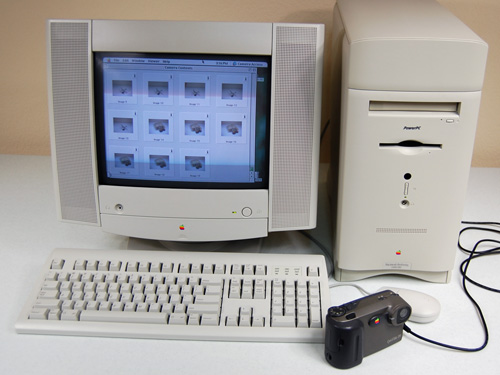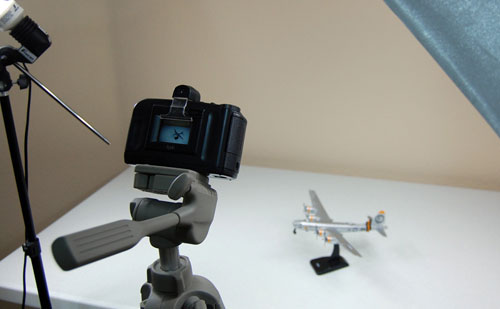Apple released the QuickTake 200 in February 1997 as a replacement for the QuickTake 150. The QuickTake 200 originally sold for $600 US. We acquired our QuickTake 200 in 2007 for $40.
The QuickTake 200 is a 24-bit color still camera built by Fujifilm for Apple Computer. The QuickTake 200 shipped with a standard 2 MB removable SmartMedia flashRAM card. Apple sold an optional 4 MB card. The QuickTake 200 is capable of producing 640 x 480, 24-bit images in high-quality or standard quality mode. High-quality images are .35 Mpx (megapixel). The standard 2 MB card can store approximately 20 high-quality images or 30 standard-quality images or a combination of the two resolutions.
System Requirements:
- A Macintosh computer with a 68040 or PowerPC processor, with 16 MB of RAM and 24 MB of available space on the hard disk drive
- A Macintosh running Mac OS 7.5 to 9
- A Macintosh with serial DIN-8 modem or printer connector (RS-422, RS-232), or GeoPort
- A CD-ROM drive for software installation
- A display that supports thousands or millions of colors is recommended for optimal viewing
Unlike its predecessors, the 200 has focus and aperture controls, and a built in liquid-crystal display (LCD) screen that allows the user to preview the images taken by the camera. Also unlike the QuickTake 100 and 150, the 200 stores images in JPEG format instead of Apple’s QuickTake PICT format. Images can be viewed in any computer without a special codec. Apple bundled the QuickTake 200 with Adobe PhotoDeluxe 1.0, Adobe PageMill 2.0, and PictureWorks NetCard 1.0 in lieu of Apple’s own PhotoFlash software, which shipped with the QuickTake 150. Apple provided its own driver and image manipulation software on a CD-ROM disc that installs Camera Access and the QuickTime IC system extension.
The QuickTake 200 connects to your Mac through a standard classic Macintosh DIN-8 serial cable that can be plugged into the modem port, printer port, or GeoPort. The Camera Access program is used to download JPEG images from the camera or to convert them to PICT, TIFF, or EXIF format before saving them to the computer. Images enhanced outside of the camera can also be pushed back into the camera using Camera Access for transport to another computer. Camera Access can be used to delete all or selected images in the camera. We used a Performa 6400/180 using Mac OS 8.6 to download from the camera the QuickTake 200 images shown on this page. Below are desktop captures showing the software.


What’s in the box:
- QuickTake 200 digital camera
- One QuickTake 2 MB SmartMedia Card
- Clip-on optical viewfinder
- Video cable for connecting to standard NTSC television (where available)
- Third-party bundled software (Adobe PhotoDeluxe 1.0, Adobe PageMill 2.0, PictureWorks NetCard 1.0)
- QuickTake software (includes Camera Access, QuickTime IC system extension and drivers)
- Serial cable for connecting camera to your Mac OS computer
- Four AA lithium batteries
- Hand strap
- QuickTake 200 User’s Guide
Third-party Bundled Software:
- Adobe PhotoDeluxe 1.0, to enhance images
- Adobe PageMill 2.0, to create web pages with images
- PictureWorks NetCard 1.0, to create Internet “picture postcards”
Accessories:
- QuickTake AC Adapter (M5707LL/A)
- QuickTake 4 MB SmartMedia Card (M5708G/A)
Specifications:
- Image quality: 640 x 480 resolutions; 24-bit color; high-quality and standard-quality modes
- Storage: Space for approximately 20 high-quality images or 30 standard-quality images or a combination on included 2 MB removable storage card
- Focus Capabilities: Focus-free lens (38 mm equivalent – fixed focus) with three focal ranges
- Close-Up: 3.5 to 5 inches
- Portrait: 17 to 35 inches
- Far: approximately 35 inches to infinity
- LCD viewing panel: 1.8 inches diagonal; provides live previewing at 30 frames per second (3-, 5-, or 10-second intervals; review of up to nine images)
- Exposure control: Through the Lens (TTL) metering; aperture-priority automatic exposure (AE) for accurate, automatic exposures
- Electronic Shutter Speeds: 1/4 to 1/5000 second
- Aperture Settings: f2.2 to f8.0; user-selectable
- Battery life: Approximately 1 hour of continuous viewing or 50 images (may vary depending on usage)
- Connectivity: Serial to Mac OS-based computers; NTSC Video output; connector for optional AC adapter
- File formats: PICT, JPEG, TIFF, EXIF
- Other features: Tripod mount; 10-second timer; power-saving mode
Features:
- Preview your images before you capture them, using the integrated LCD.
- Capture high-quality digital still images, perfect for newsletters, catalogs, presentations, Internet publishing, and numerous other applications.
- View stored images (up to nine at a time), delete selected ones, and protect others from accidental deletion.
- Transfer your digital photographs to your Mac easily using the included serial cable.
- Use the photo-enhancement software to create just the results you envision.
- Place the finished results back into the camera to take them along with you in the most convenient way possible.
- Connect your camera directly to a standard NTSC television via the included video cable for an easy, effective means of sharing your images with others.
- Store images on tiny, convenient removable storage cards; a 2 MB card is included.
- Transfer images directly from storage cards to any computer with a PC Card slot by using an optional adapter.
The QuickTake 200 is a substantial improvement over the QuickTake 100 and 150. Unlike the earlier QuickTakes, the 200 has a built in LCD screen that allows users to preview and delete selected images while in the camera. The camera also has rudimentary focus controls. There are three fixed focus settings as shown below, which can be selected using a toggle knob on the top of the camera. The built in LCD gives the user an impression of what each focus setting will look like. The LCD is not crystal clear, but you can tell if something is out of focus.
The QuickTake 200 has two aperture settings (light settings). The user can switch between f2.2 and f8.0. f2.2 is used in low light settings and f8.0 is used in bright light. If the camera thinks you are underexposing or overexposing the image, it will warn you by suggesting you switch to the opposite aperture setting.
The QuickTake 200 has a camera mode dial to select modes. The modes are described below:
Here is the cleaned-up text version of the chart without the “Icon” column:
| Mode | Description |
|---|---|
| Computer mode | Use this mode, along with the included Mac OS based computer cable, to transfer images from the camera to your computer. (PC-Mode appears on your LCD screen.) |
| Self-Timer mode | Use this mode to set the camera to take a picture after 10 seconds. |
| Record mode | Use this mode to take good-quality pictures. |
| Record-Fine mode | Use this mode when you want the highest picture quality. You can also change the date and time in this mode. |
| Play mode | Use this mode to view single or multiple camera images on the LCD screen. |
| Auto-Playback mode | Use this mode to automatically play back consecutive frames on the LCD screen. You also use this mode to view images on your television. |
| Protect mode | Use this mode to prevent images from being erased. |
| Erase mode | Use this mode to erase a single image, erase all images on the storage card, or to format the storage card. |
The QuickTake 200 uses four AA batteries. Apple shipped the 200 with four lithium ion batteries. When the batteries are low, the battery warning flashes on the LCD screen to remind you to replace the batteries. The camera turns itself off when the batteries get too low to use. The camera is turned on by toggling a power switch located just above the top right corner of the LCD. When the camera is on, the LCD screen displays live, video images. The 200 automatically switches itself off when you do not use it for more than 2 minutes as a way to conserve batteries and to save power when you use the optional AC power adapter. The auto-power-off function does not operate in Computer mode. To disable the auto-power-off function in all modes, hold down the action button while turning on the camera. Apple sold an optional QuickTake 200 AC Adapter. Use only the QuickTake 200 AC Adapter with the QuickTake 200 camera. The use of other power sources might cause a fire. The power adapter does not recharge batteries in the camera.
The QuickTake 200 shipped with a snap on viewfinder to use when you are taking a series of pictures, when you want to conserve the batteries, or when you are outdoors and sunlight is distorting the LCD screen view. Do not use the close-up focus with the viewfinder. It is not accurate, because the parallax correction is off. To install the optical viewfinder, hook the viewfinder to the front of the camera first, then hook it to the back of the camera. Remove it in the same way. Never pull the viewfinder straight off the camera.
We found the viewfinder to be useful in framing an image. It is puzzling to us why this had to be a snap on. It would seem logical to have this permanently mounted on top of the camera. Also, constantly attaching and removing the viewfinder can easily lead to scratching the camera case unless you are constantly careful. It must be noted that the QuickTake 200 camera is slow, so successive images are difficult to take if you don’t know what you are looking at because the LCD won’t refresh fast enough, hence the need to look in the viewfinder to take a “series of pictures”.
The QuickTake 100 and 150 used 1 MB Flash EPROM as non-removable internal memory. The QuickTake 200 improved upon its processors by using a removable SmartMedia flash memory card. Apple shipped the 200 with a standard 2 MB card and offered an optional 4 MB card. Larger cards could be purchased through other vendors. Before you can use your QuickTake 200 camera, you must install a storage card. Upon initial installation, cards must be formatted using the Erase mode Format function. If a card is not in the camera, a NO CARD message flashes on the LCD screen when you turn on the camera. SmartMedia cards gave users another means of transferring images to computers via a 5v SmartMedia compatible card reader.
The QuickTake 200 has a composite video out port. You can create a QuickTime movie using your camera and Camera Access software. To use the Camera Access “Video-in” function, your Mac must be AV-compatible. You can also use the video out port to view images on a television. The QuickTake 200 cameras sold in the United States require a TV that is NTSC (National Television System Committee) compliant.
Apple sold the QuickTake 200 for about a year before completely getting out of the camera equipment business altogether. The QuickTake 200 was considered a good overall camera in 1997 and it is markedly superior to the older QuickTake 100 and 150. For an Apple collector, the QuickTake 200 is the best Apple branded camera and as such it is a must have.
